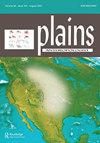Red pigment in the Central Plains: A Pawnee case at Kitkahahki Town
Q2 Social Sciences
引用次数: 0
Abstract
James Murie, early twentieth century ethnographer and member of the Pawnee Nation, once wrote that the “things that are most acceptable to the Pawnee gods are smoke, fat, paint, and flesh” (Murie 1981:466). Here we describe red paint at Kitkahahki Town, a late eighteenth–early nineteenth-century Kitkahahki Pawnee village in north-central Kansas. Using laser ablation inductively coupled plasma mass spectroscopy and Raman spectroscopy, we compare archaeological paint and pigment samples to three pigment materials – pipestone powder, vermilion, and ochre – all documented in the Great Plains after European colonization. We ultimately find no evidence of pipestone powder or vermilion as pigment at Kitkahahki Town and conclude that ochre (some of which may be from the Lower Cretaceous Dakota formation) is the most likely pigment material at the site. Ochre may have been especially significant because of links between this earth pigment and Pawnee sacred geography.中原地区的红色色素:Kitkahahki镇的一个典当案
20世纪初的民族志学家、波尼族成员詹姆斯·穆里曾写道,“波尼神最能接受的东西是烟、脂肪、油漆和肉”(穆里1981:466)。在这里,我们描述了位于堪萨斯州中北部的18世纪末至19世纪初的Kitkahahki Pawnee村的红漆。使用激光烧蚀电感耦合等离子体质谱和拉曼光谱,我们将考古涂料和颜料样品与三种颜料材料——管道石粉末、朱红色和赭石——进行了比较,所有这些都是欧洲殖民后在大平原记录的。我们最终在Kitkahahki镇没有发现任何证据表明细粉或朱红色是颜料,并得出结论,赭石(其中一些可能来自下白垩纪达科他地层)是该遗址最有可能的颜料材料。Ochre可能特别重要,因为这种地球颜料和Pawnee神圣地理之间的联系。
本文章由计算机程序翻译,如有差异,请以英文原文为准。
求助全文
约1分钟内获得全文
求助全文

 求助内容:
求助内容: 应助结果提醒方式:
应助结果提醒方式:


